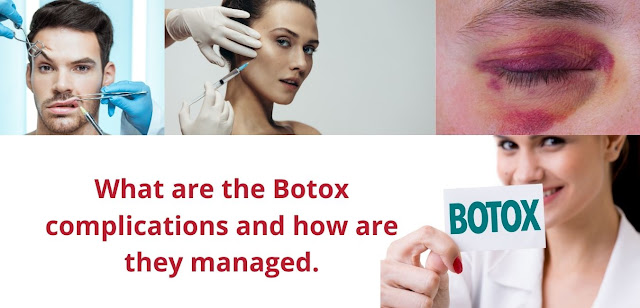Botox Injection is the most performed cosmetic procedure in the world simply because the satisfaction rate is around 96%.
I'm going to explain everything you need to know about botox, its history, what botox really contains. And of course the main advice for patients who have never had botox injections as well as the possible side effects, and finnaly what are the Botox complications and how are they managed.
First of all The history of Botox:
Botox is a neurotoxin made by the bacterium Clostridium botulinum.
It muscle contraction by blocking the transmission of nerve signals as well as neuromuscular transmission via synapses.
It thus enables dynamic facial wrinkles to be treated aesthetically. It is also used therapeutically to treat strabismus muscle spasms, urinary incontinence, and healthy facial spasms as well as migraine.
Botulinum toxin (Botox) has revolutionized the treatment of patients with blepharospasm, hemifacial spasm and Meige syndrome.
Prior to its use, the majority of patients with these issues who sought treatment underwent extensive surgeries, including partial resection of the 7th nerve and extensive dissection of the orbicularis and associated facial muscles.
How did botox start to be used for cosmetic purposes?
In fact it's in the 90s; a couple of canadian doctors noticed that the patients who had injections of botulinum toxin for therapeutic purposes around the eyes had less wrinkles at the injection site and that's how botox started to be used at aesthetic purposes.
It was in 2002 that botox was authorized for aesthetic purposes, in particular for frown lines, crow's feet rites, forehead wrinkles, frown lines injections.
How do botox injections work?
This is because Botox has the advantage of reducing the appearance of fine lines and wrinkles with simple injections.
This procedure, less invasive than surgery, has proven its effectiveness but is not without risks and side effects.
Are Botox Injections For Everyone? What are the risks? Here's everything you need to know about Botox injections.
What are the Botox complications and how are they managed ?
Loco-regional complications
- Headaches: they may be present after the first injections and disappear after a few hours to a few days.
- Eyebrow ptosis: Botox injection of the forehead may cause the eyebrows to droop slightly. This descent is usually due to the fact that the eyebrows were decayed in the low position before the injection.
- Eyelid ptosis: Botox injection of frown lines can cause partial fall of the upper eyelid which can last 4 to 8 weeks. It is rare (less than 1% of cases), and always disappears after a few weeks.
- Discomfort or smile and when swallowing: Injecting botox into the lips may cause discomfort when smiling or small abnormal movements. The injection into the neck may cause difficulty in swallowing.
- Dry eye: by decreased tear secretion which may lead to keratitis, especially in patients with contact lenses (in this case, care should be taken to hydrate the cornea well).
- Paradoxical contraction of a muscle and mimicry disturbances: In the days following the injection, the treated muscles may show a few paradoxical movements (spontaneous contractions) without seriousness.
- small imperfections: remaining fine lines.
- asymmetry: especially in cases where the asymmetry was present before the injection.
General complications
They are quite exceptional:
- Allergic reaction: rash, hives, general allergic reaction.
- nausea, dizziness
- fatigue, fever, flu syndrome
- dry skin or mouth.
Complications from Botox are rare, but the injectable can cause serious side effects in some people.
- Swallowing problems
- Respiratory problems
Note that complications are rare and reversible.
To summarize
Hope this article helps you answer some of the questions you might have if you are considering Botox treatments.
Botox has many advantages; it has been around for anti-aging purposes since 2002 and can also be used for a number of medical treatments including hyperhidrosis, migraines, symptoms of overactive bladder, and cervical dystonia.
Additionally, a 2009 study published by the Journal of Cosmetic Dermatology proved that patients who had Botox injections had lower depression, anxiety, and irritability than patients who did not.
In addition, Botox patients did not feel more or less attractive than others. In other words, the improved mood of the Botox group not only made them more confident, but also happier.
References 1

